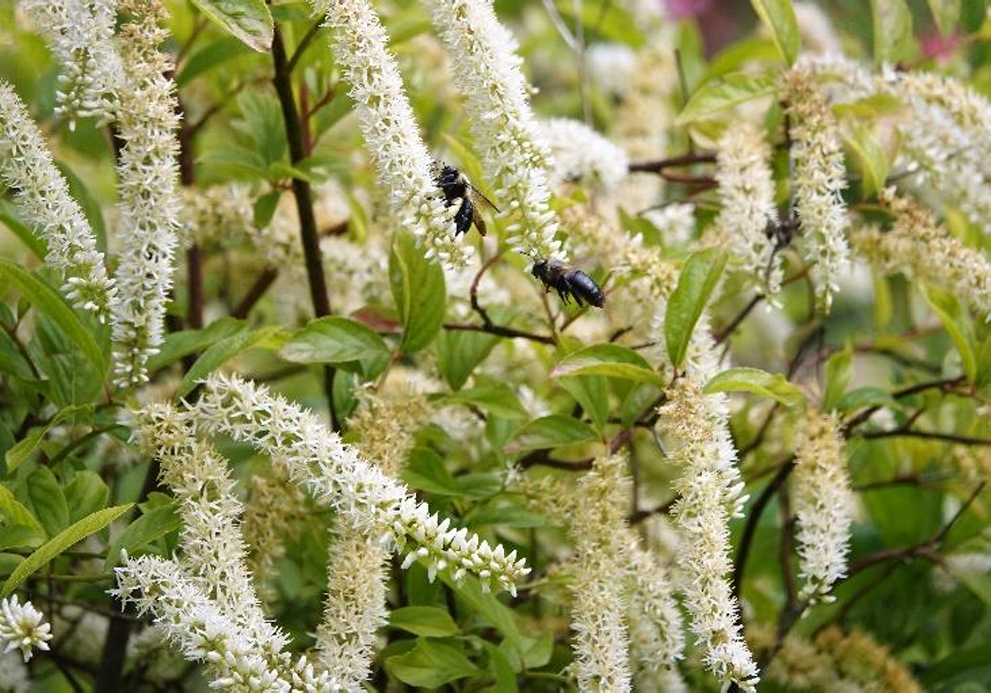Plant of the Month May 2023: Virginia Sweetspire
Virginia Sweetspire, Itea virginica
Betsy Washington
Long-lasting sweetly scented racemes of white flowers
Virginia Sweetspire, Itea virginica, is a stunning deciduous to semi-evergreen shrub and the perfect choice for our May Plant of the Month as the long racemes of white flowers are just beginning to open on this first day of May. Typically growing from 3 - 5’ high and 4 – 6’ wide, Virginia Sweetspire has gracefully arching branches which form a dense mound and appear to cascade down dramatically when in bloom. During May and early June, it is literally covered with drooping white ‘spires’ or racemes of fragrant flowers up to 6” long. Flowers are nectarrich and are magnets for many pollinators such as bees and butterflies. Their small seeds are housed in tiny tan capsules and relished by songbirds while the dense mounded habit provides shelter for birds and other wildlife.
This mounding shrub offers interest in every season with brilliant orange, red to maroon colors glowing in fall, especially when backlit by the low-angled fall sun. The arching stems turn a dark purple red on top in winter where they are exposed to sun, adding winter interest and a few brilliant red leaves persist into winter sparkling like colored jewels in our often-drab winter landscape.
Sweetspire’s natural habitat is swamp forests, seeps, stream banks and acidic floodplain forests where it is common throughout the Coastal Plain. In the garden, this shrub is super adaptable and maintenance free; it tolerates occasional flooding and wet soils but once established is also surprisingly drought tolerant. It often suckers in moist soils to form dense colonies preventing erosion and stabilizing streambanks and steep slopes. Virginia Sweetspire grows in full sun where the flowers and fall color are more profuse, yet it tolerates heavy shade where it may grow taller and be more open but still manage to bloom. Use this mid-sized shrub along streams and low wet areas or to stabilize banks, helping to prevent erosion. It is also perfect for a rain garden where it can tolerate the alternating wet to dry soil with aplomb. Virginia Sweetspire is especially lovely planted in masses or used as a mid-sized ground or bank cover. It is handsome enough to use in formal gardens as a hedge or accent plant where it will add color and year-round interest to any r garden. The flowers grow from new wood, so it is best pruned (if even needed) right after blooming. Any errant root suckers can be removed to create new plantings.
Itea glowing red by the water in fall
My first Sweetspire was dug from a root sucker on the wet banks of the Dragon Run River on our family farm many years ago and I used it as a specimen plant, to replace a declining weeping Japanese Maple in a tight spot beside a bluestone patio. It won my heart immediately with its exceptional adaptability and its fragrant masses of cascading white flowers falling onto the patio and softening the edge. In summer the leaves remained handsome dark green with occasional reddish tints. In fall its brilliant fall was a stunning sight with leaves like crimson stained glass as the low-angled western sun made them glow. And in winter, the arching red stems and a good number of jewel-tone leaves remained colorful against the drab winter landscape adding so much life to the winter garden. On another property, I used Virginia Sweetspire in low masses to stabilize a steep bank above a lake where it was a standout in every season. Here in the Northern Neck, it accents my coastal property along either side of a long garden walk to the water adding year-round structure, seasonal color all while attracting loads of birds and butterflies to my pollinator garden. I can’t imagine gardening without this beautiful and adaptable shrub!
The flowers are butterfly magnets - with American Lady
Red Admiral
Cascading flowers drape over a seawall





